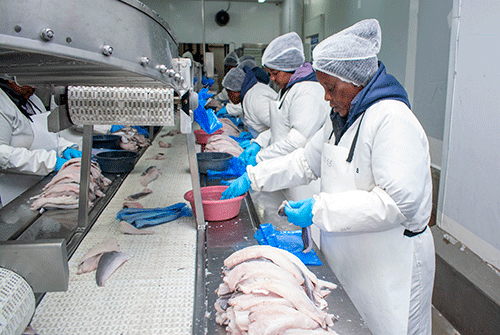Namibia’s total fish exports, which include crustaceans, molluscs and other aquatic invertebrates, reached N$3.4 billion during the final quarter of last year, marking a sharp increase from the N$2.8 billion recorded in 2022.
These figures are contained in the Namibia Statistics Agency’s (NSA) latest Agriculture and Fishing Indicators Statistical Bulletin, which was published last week.
Total landings of quota species for the period under review amounted to 77 511 metric tonnes, which is a slight decline of 5.3% when compared to the 81 846 metric tonnes recorded in the corresponding quarter of 2022. Most fish species’ landings dropped, except for hake, which recorded an increase of 10.2% in the last quarter of 2023. Hake recorded the highest landings of 46 442 metric tonnes, followed by horse mackerel, which registered 27 135 metric tonnes, and tuna in third place with 1 952 metric tonnes.
In terms of export destinations, Namibia’s fish products were mainly exported to Spain, which accounted for 37.9% of total exports during the period under review. The products which were shipped there were mainly frozen hake fillets.
Namibia’s second-largest export destination was Zambia, which accounted for 20.7% of the export share, and the leading product thereto was horse
mackerel.
One of Namibia’s biggest trading partners, South Africa, fetched 8.8% of total exports mainly through the purchase of frozen fillets of hake, placing it in third place as one of the country’s leading fish product importers.
Imports
In terms of Namibia’s fish product imports, the value of total imports for the period under review stood at N$130.5 million, compared to N$439.6 million recorded in the third quarter of 2022.
“Products of fish and crustaceans, molluscs and other aquatic invertebrates were mainly imported from South Africa, accounting for 36.0%, mainly importing hake. Spain came in second, accounting for 18.3% of imports, and products which were imported from this country were mainly cuttlefish and squid,” reads the NSA report.
The country also imported various fish products from the South American archipelago, the Falkland Islands, which accounted for 16.5% of imports. The main imported products were also cuttlefish and squid.
Fishing is one of Namibia’s leading industries, contributing about 6.6% to the country’s GDP since 2007, and approximately over 20% of export earnings.
Government has been largely successful in sustainably managing its marine resources, with the fishing industry regarded as the country’s second-biggest export-earner of foreign currency after mining.
Globally, Namibia ranks amongst the top 10 fishing countries in terms of the value of production, and in terms of its 400kg per capita annual production, it ranks second in the world.
Namibia is also the top African fisheries’ country by production value and exports, and her estimated national fish reserves are the biggest in Southern Africa.
However, the fishing industry and the Namibian economy faced some challenges in recent years, especially following the pilchard (sardine) industry’s decline due to alleged overfishing and natural events such as the Benguela-Nino climate crisis.
But mariculture has now become another sustainable way of creating employment and increasing economic growth in the fishing sector, which includes the cultivation of oysters in the sheltered Walvis Bay as well as ponds north of Swakopmund. Namibian oysters have become sought-after locally and abroad.
-ohembapu@nepc.com.na


